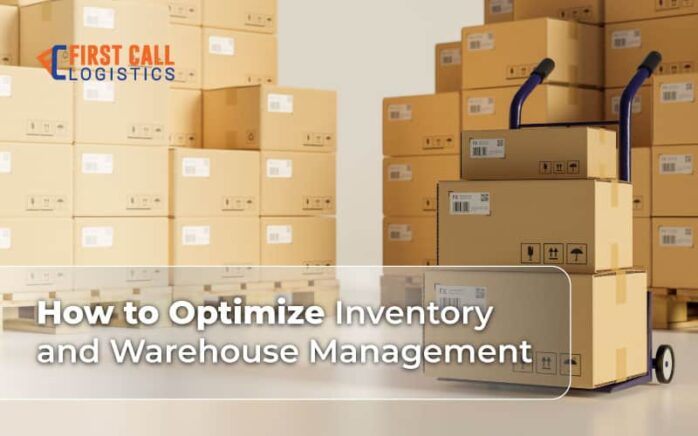How to Optimize Inventory and Warehouse Management

The shipping industry often uses the terms “warehouse management” and “inventory management” interchangeably, but they’re actually two different sets of responsibilities — and each is vital to the success of any business’s supply chain.
Let’s take a closer look at warehouse and inventory management, and why they matter to you.
Warehouse Management vs. Inventory Management
The reason these terms can be so confusing to outside observers is they’re actually related to each other. In fact, they have a slight overlap.
Warehouse management is an umbrella term referring to any type of activity or function that takes place within the warehouse. This includes everything that happens from the moment a product enters the warehouse to ensure it leaves and arrives at its final destination.
Common warehouse management tasks include:
- Coordinating the arrival and unloading of incoming freight
- Tracking inventory using barcodes, RFIDs, and warehouse management systems
- Optimizing warehouse space for efficient picking and packing
- Ironing out the logistics of shipping products with the correct carrier to ensure they arrive on time
- Handling returns, damage claims, and replacement products
- Reporting on inventory turnover, on-time delivery rates and other important warehouse success metrics
Inventory management is more limited in scope, focusing purely on ensuring the warehouse is always stocked with the right amount of inventory at any given time.
The responsibilities of inventory management include:
- Inventory forecasting (planning for fluctuations in demand)
- Tracking inventory while it’s in the warehouse
- Storing inventory in a safe, efficient manner
- Enacting plans to resolve and prevent backorders
Why the Distinction?
So, why the distinction between warehouse and inventory management? And is it really all that important to look at them separately?
Based on our years of experience within the industry, the answer is yes!
Proper inventory management is foundational to successful warehouse management. When you have the right amount of inventory in the right location at the right time, you can quickly fill orders and operate the warehouse at peak efficiency.
Too much inventory, and you’re losing money to all the extra product that’s sitting around taking up limited space in the warehouse. Too little, and you’re dealing with backorders and lost opportunities due to restocking and shipping wait times.
Without proper inventory management, a domino effect slows down all other warehousing activities and processes. Taking time to track and analyze inventory, plus utilizing the latest industry technology dedicated to predicting swells in demand, will help you meet demand without falling behind on orders or creating an expensive inventory surplus.
Improving Your Inventory and Warehouse Management
Here are four things you can do now to take your company’s inventory and warehouse management up a notch:
1. Upgrade your tracking software. Small warehouses may be able to get away with manually logging inventory and tracking warehouse functions, but as your business scales you’ll need the benefits that come with digital recordkeeping and warehouse automation.
2. Optimize warehouse space. Don’t allow space to go to waste! Create a clear system for organizing bins and pallets. Standardizing the types of bins and compartments used can also help ensure storage units fit tightly together.
3. Add images and product descriptions to your logs. This information pays off heavily in the long run. The images and descriptions enhance workers’ ability to pick orders with greater accuracy and mitigate misplaced products by making it easier to stock and return items to the correct bin locations.
4. Avoid “just-in-case” buying. In response to supply chain disruptions, some warehouses implement a “just-in-case” inventory management system in which they purposefully overstock all products beyond their usual inventory amounts. While the logic of using higher quantities to create a buffer to lessen the impact of shortages is sound, this practice is not sustainable in the long run and introduces a high risk of being stuck with racks full of outdated products.
How a 3PL Can Help with Inventory and Warehouse Management
If you’re struggling to optimize your warehouse and inventory management, partnering with a reliable 3PL is one of the best things you can do.
As veterans of the shipping and storage industry, the First Call team has worked with a variety of companies and industries over the years, refining our processes over time to ensure effective storage for our partnering businesses. As an asset-based 3PL, First Call offers its own warehouse storage and distribution services, as well as industry-leading WMS technology for maximum inventory visibility.
Ready to get started? Contact First Call today and learn how we can help with all of your warehousing needs.
Streamline Delivery with Flexible Storage Solutions
Speedy delivery is crucial to any growing business. First Call’s Warehousing & Distribution Services can help establish resilient supply chains, deliver products on time and achieve long-term business goals.
More Resources on Warehousing and Distributions Solutions:
- Article: The Basics of 3PL Warehousing Services
- Article: FIFO vs. LIFO: Which Inventory Management is Right for You?
- Article: Optimize Your Supply Chain with Decentralized Warehousing
- Article: Why All Ecommerce Businesses Need Reverse Logistics Management
- Article: Why Every Business Needs Efficient LTL Shipping
- Article: Understanding Cross-Docking Services
Get the latest supply chain news and updates directly to your inbox.